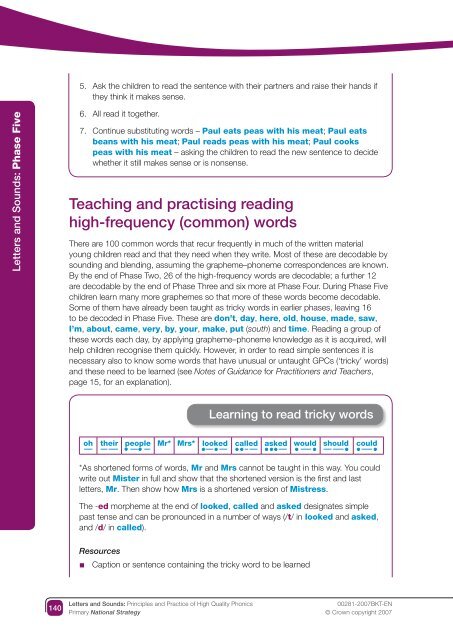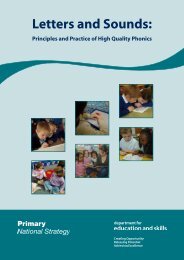Letters and Sounds: Phase Five
Letters and Sounds: Phase Five
Letters and Sounds: Phase Five
You also want an ePaper? Increase the reach of your titles
YUMPU automatically turns print PDFs into web optimized ePapers that Google loves.
<strong>Letters</strong> <strong>and</strong> <strong>Sounds</strong>: <strong>Phase</strong> <strong>Five</strong><br />
0<br />
5.<br />
6.<br />
7.<br />
Teaching <strong>and</strong> practising reading<br />
high-frequency (common) words<br />
There are 100 common words that recur frequently in much of the written material<br />
young children read <strong>and</strong> that they need when they write. Most of these are decodable by<br />
sounding <strong>and</strong> blending, assuming the grapheme–phoneme correspondences are known.<br />
By the end of <strong>Phase</strong> Two, 26 of the high-frequency words are decodable; a further 12<br />
are decodable by the end of <strong>Phase</strong> Three <strong>and</strong> six more at <strong>Phase</strong> Four. During <strong>Phase</strong> <strong>Five</strong><br />
children learn many more graphemes so that more of these words become decodable.<br />
Some of them have already been taught as tricky words in earlier phases, leaving 16<br />
to be decoded in <strong>Phase</strong> <strong>Five</strong>. These are don’t, day, here, old, house, made, saw,<br />
I’m, about, came, very, by, your, make, put (south) <strong>and</strong> time. Reading a group of<br />
these words each day, by applying grapheme–phoneme knowledge as it is acquired, will<br />
help children recognise them quickly. However, in order to read simple sentences it is<br />
necessary also to know some words that have unusual or untaught GPCs (‘tricky’ words)<br />
<strong>and</strong> these need to be learned (see Notes of Guidance for Practitioners <strong>and</strong> Teachers,<br />
page 15, for an explanation).<br />
<strong>Letters</strong> <strong>and</strong> <strong>Sounds</strong>: Principles <strong>and</strong> Practice of High Quality Phonics<br />
Primary National Strategy<br />
Learning to read tricky words<br />
oh their people Mr* Mrs* looked called asked would should could<br />
*As shortened forms of words, Mr <strong>and</strong> Mrs cannot be taught in this way. You could<br />
write out Mister in full <strong>and</strong> show that the shortened version is the first <strong>and</strong> last<br />
letters, Mr. Then show how Mrs is a shortened version of Mistress.<br />
The -ed morpheme at the end of looked, called <strong>and</strong> asked designates simple<br />
past tense <strong>and</strong> can be pronounced in a number of ways (/t/ in looked <strong>and</strong> asked,<br />
<strong>and</strong> /d/ in called).<br />
Resources<br />
■<br />
Ask the children to read the sentence with their partners <strong>and</strong> raise their h<strong>and</strong>s if<br />
they think it makes sense.<br />
All read it together.<br />
Continue substituting words – Paul eats peas with his meat; Paul eats<br />
beans with his meat; Paul reads peas with his meat; Paul cooks<br />
peas with his meat – asking the children to read the new sentence to decide<br />
whether it still makes sense or is nonsense.<br />
Caption or sentence containing the tricky word to be learned<br />
00281-2007BKT-EN<br />
© Crown copyright 2007
















